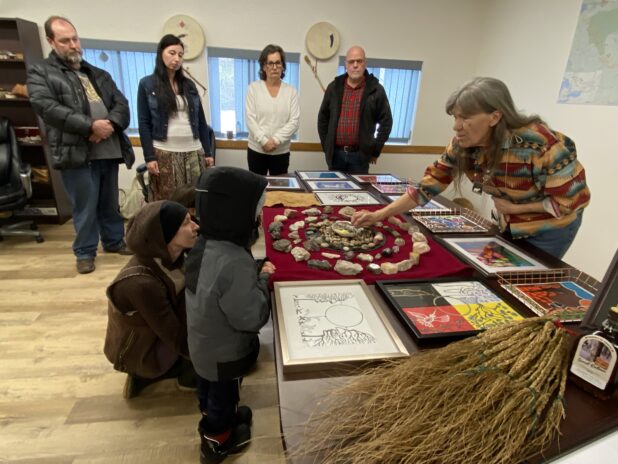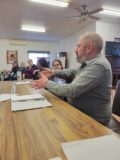Headline News
Artist inspires awareness of Algonquin culture and colonization
March 23, 2023

By Nate Smelle
On Saturday, March 18 the Kijicho Manito Madaouskarini Algonquin First Nation hosted a special afternoon event with Algonquin artist White Bear Standing, Sherry Crawford at their office on Hwy 62 in L’Amable. After transforming the space into a “Pop-Up Art Gallery” Crawford the event featured an exhibition of Crawford‘s paintings on display throughout the space.
With many community members showing up early to view the art and wish the artist a “Happy Birthday”, Crawford took time to personally greet attendees, and discuss her creations with anyone interested learning more. The purpose of the event, she told Bancroft This Week, was to bring people together to experience and receive cultural teachings through art.
Through Crawford’s education and career in social work, she found herself compelled to develop a deeper understanding of her own sense of spirituality. As part of her journey of self-discovery, Crawford said she began studying different religions, but always felt there was something missing. Feeling drawn to her Algonquin heritage, she felt most in tune with the Anishinaabe principles to live by known as the Seven Grandfather teachings of love, respect, courage, honesty, wisdom, humility, and truth. As Crawford’s career as an artist started to take off 13 years ago, she realized that she could help others understand these teachings better with her art.
“I got more into my art and out of the whole social work thing, because a lot of energy goes into that, and there are a lot of really horrible stories,” Crawford said. “So, I decided that for me art was a better way to be able to share some of the teachings. People can heal through art, and I can make that connection through my art.”
Speaking with the audience at the exhibition on Saturday, Crawford explained the sources of inspiration for her work, and the meaning behind several of her paintings. She then led the group through a demonstration on the effects of colonization and residential schools on Indigenous communities that are still being experienced to this day.
On the table in front of Crawford, she had set up a series of five concentric circles using different sized stones. Explaining the significance of each of the circles, she first pointed to a shell in the centre of the circles. Representing the culture at the heart of the community, the shell contained sweet grass, cedar, tobacco, and sage to mark the importance of the medicines, drumming, dancing, and ceremonies that bind Indigenous communities together. Surrounding the shell was another circle filled with small shiny stones signifying the community’s children.
Around the outside of the children’s circle, Crawford next drew attention to a circle of larger stones representing the mothers and aunts who look and teach after the children. Along the outer edge of this circle were several even larger stones which she identified as the Grandmothers, Grandfathers, and Elders of the community who were there to help the mothers and aunts share their culture with the children. The outermost circle was made up of the largest stones, which she explained represented the men who are the warriors, hunters, and protectors.
Acknowledging how interdependent each of these circles are, Crawford said “Everybody had a job, and everybody knew what their job was, and everybody did their job well … And then, colonization happened.”
She continued, “You have heard the word ‘genocide’ — we use it a little more often today than we did in the past — well, that’s basically what happened. They were telling us that we weren’t not allowed to use our medicines, we were not allowed to drum, we weren’t allowed to dance, we weren’t allowed to practice any of our ceremonies, we were beaten, we were thrown in jail, we were often killed.”
To illustrate how, in an attempt to erase Indigenous people and culture, colonizing forces created and used the residential school system to take away the heart of Indigenous communities, Crawford removed the shell and asked two of the children in attendance to collect the small stones nearest the centre representing the Indigenous children, and place them in a box.
“Along came the churches, and the government, and they decided that our children would be much better off if they take them out of the community, and put them in these wonderful boxes that they called residential schools. So, one by one the children were removed, not by choice, not willingly, but by brute force.”
Crawford then picked up the box full of small stones, and moved the box to the far side of the room to demonstrate how Indigenous children were stolen from their families and communities. Pointing to the empty space know in the centre where the children and culture once were, she then showed how colonizers attempted to fill this void with alcohol, drugs, gambling, and religion. Over time, Crawford explained how these efforts to try and erase Indigenous culture have manifested into an intergenerational trauma which can only start to heal when all Canadians are willing to: take time to understand the true history of colonization; and foster meaningful reconciliation with Indigenous people and communities.
Following Crawford’s demonstration, she gave the audience a chance to ask questions abouther demonstration and art.
“With the balance, there is going to be that negativity with the sadness and all that terrible stuff, but there also is a lot of good,” Crawford told Bancroft This Week. “The colnizers, look what they’ve built; they’ve built cities, our hospitals, our universities. So it’s not all bad. We take the good with the bad.”
To find out more about Crawford’s art and cutural teachings, visit her website at: www.whitebearstandingcreative.ca.


















